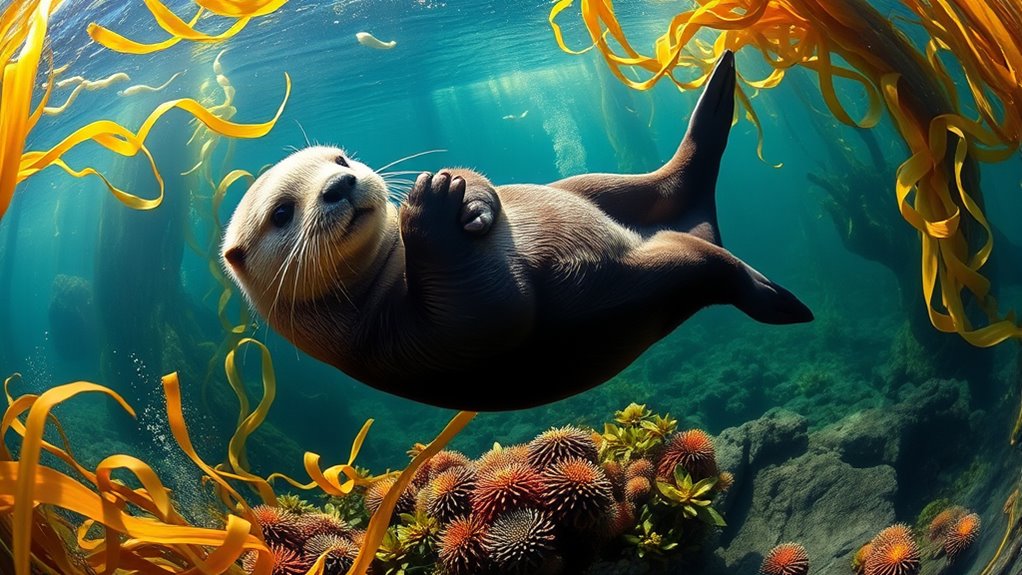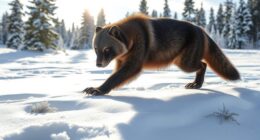Sea otters are keystone species essential for healthy kelp forests. By preying on sea urchins, they keep their populations in check, preventing the destruction of kelp. This critical interaction promotes biodiversity, as healthy kelp forests provide habitat for numerous marine species. When otter populations decline, unchecked sea urchins can devastate these ecosystems. Conserving sea otters not only benefits them but also supports the overall health of marine environments. There’s much more to uncover about their impact!
Key Takeaways
- Sea otters are keystone species that regulate sea urchin populations, preventing kelp forest destruction.
- Their predation maintains the balance of marine ecosystems, supporting biodiversity in kelp forests.
- Healthy kelp forests, sustained by otters, provide essential habitats for various marine species.
- Protecting sea otters through conservation efforts positively impacts marine environments and biodiversity.
- Educating others about the importance of sea otters fosters support for marine conservation initiatives.

Sea otters are fascinating creatures that play a essential role in their marine ecosystems. These adorable mammals aren’t just cute; they’re considered keystone species, meaning their presence greatly impacts their environment, particularly kelp forests. You might be surprised to learn that otter behavior directly influences the health of these underwater forests, and understanding this relationship is critical for effective marine conservation efforts.
When you observe sea otters, you’ll notice their playful nature and unique habits. They often float on their backs, using rocks to crack open the hard shells of sea urchins. This behavior isn’t just entertaining; it’s indispensable for maintaining a balance in the marine ecosystem. Sea urchins, when left unchecked, can decimate kelp forests, leading to a decline in biodiversity and the overall health of the marine environment. By preying on these urchins, otters help preserve the kelp, allowing it to thrive and provide habitat for countless marine species.
In terms of marine conservation, protecting sea otters can have a ripple effect on their ecosystems. When you support conservation initiatives aimed at otter populations, you’re also safeguarding their habitats. This can include efforts to reduce pollution, manage fisheries sustainably, and protect coastal areas from development. Each step taken to preserve otters contributes to the health of kelp forests, which in turn supports a diverse array of marine life, from fish to invertebrates.
You might wonder how you can get involved in marine conservation efforts focused on sea otters. One way is to educate yourself and others about the importance of these animals and their habitats. By sharing knowledge and advocating for policies that protect marine ecosystems, you can make a difference. Supporting organizations dedicated to marine conservation can also amplify your impact, as they often work on the frontlines to guarantee the survival of sea otters and their habitats.
Frequently Asked Questions
How Do Sea Otters Communicate With Each Other?
Sea otters communicate with each other through various vocalizations and social behaviors. You’ll notice they use chirps, whistles, and growls to express emotions or alert others to danger. During social interactions, they engage in playful behaviors, like sliding down kelp or floating in groups. These actions strengthen their bonds and help maintain group cohesion. By observing their vocalizations and playful antics, you can gain insight into their complex social lives.
What Is the Average Lifespan of a Sea Otter?
Did you know that a sea otter’s lifespan can be around 15 to 20 years in the wild? These playful creatures thrive in coastal habitats, feasting on a diverse diet that includes sea urchins, crabs, and fish. Their foraging habits help maintain kelp forests, showcasing their essential role in the ecosystem. So, the next time you spot a sea otter, remember they’re not just adorable; they’re indispensable to their underwater home!
Do Sea Otters Have Any Natural Predators?
Yes, sea otters do have natural predators. Their main threats come from orcas and great white sharks. However, you’ll find that sea otters use predator avoidance techniques, such as diving and quickly swimming away when danger approaches. They also employ camouflage strategies by resting among kelp, which helps them blend into their surroundings. By doing this, they increase their chances of escaping from potential predators lurking nearby.
How Do Sea Otters Care for Their Young?
Did you know that sea otters can hold their breath for up to five minutes while diving for food? When it comes to caring for their young, you’ll notice they exhibit fascinating mating behaviors and denning habits. Mothers often wrap their pups in kelp to keep them from drifting away while they hunt. They’re incredibly attentive, grooming and keeping their young warm, ensuring they’re safe and learning essential survival skills in their early days.
What Threats Do Sea Otters Face Today?
Today, sea otters face several threats, including pollution impacts and habitat loss. When you consider marine conservation, you’ll see that oil spills and plastic debris profoundly affect their health and food sources. Additionally, climate change alters their habitats, making it harder for them to thrive. It’s essential to support initiatives that address these issues to help protect sea otters and their ecosystems for future generations. Every effort counts in this critical conservation work!
Conclusion
In the grand tapestry of marine ecosystems, sea otters play a role akin to that of a wise king, ensuring balance and harmony in their domain. By keeping sea urchin populations in check, these playful creatures protect the lush kelp forests that serve as a sanctuary for countless species. So, the next time you think of the ocean’s wonders, remember that the sea otter is not just a charming mascot but a crucial guardian of underwater life.









